When the power went out during the blackout of Aug. 14, 2003, 50 million people across the Northeast, from New York City to Toronto, were left in the dark. And in a rare moment that night, looking up to the sky, people could see the Milky Way.
Roughly one-third of the world, including 80% of North Americans, are unable to see this bright band of stars that makes up the outer rim of our galaxy. Without light pollution, about 2,500 stars should be visible to us at night, but in most suburbs only a few hundred can be spotted with the naked eye.
The artificial light we live with — beaming down on our sidewalks, flooding the roads and rising up in a glowing dome over the land — affects everything from our sleeping habits (and with that our physical and mental health) to the nocturnal eating, mating, migrating and pollinating habits of many bats, birds and bugs.
Some places, however, are taking action to protect the night sky. In the United States, at least 18 states, as well as the District of Columbia and Puerto Rico, have laws to reduce light pollution. Communities are increasingly taking steps, such as consulting with ecologists on lighting design and designating remote areas as dark sky preserves, to protect this vital, yet overlooked, natural resource.
Four years ago, Fort Collins, Colorado, set a simple goal: a darker night sky as part of a broader effort to connect residents to nature.
Currently, the local government is working on establishing important baselines: How bright is the city now, and how much darker should it be? It’s also rethinking building codes, establishing connections with developers and educating the public about the importance of dark skies so that it can turn its simple goal into clear, achievable targets — all while maintaining public safety.
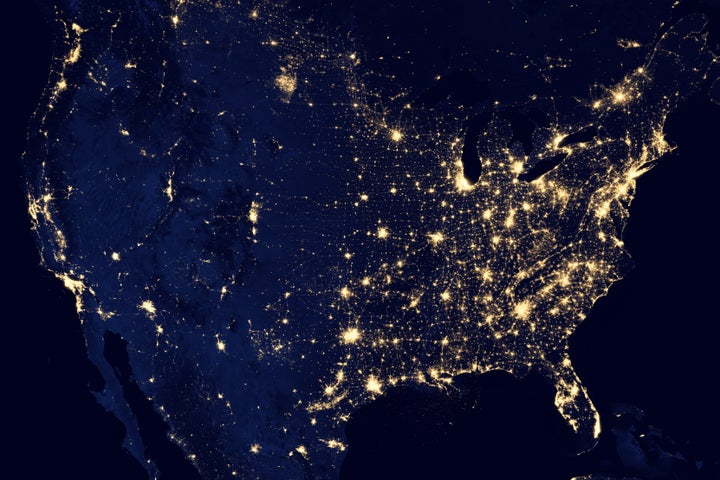
“I think people are still very much learning,” says Ginny Sawyer, project and policy manager for the city of Fort Collins, of public awareness around protecting the night sky. “[They’re] learning about the idea of why it’s even important or why it might be important or be of value. I think we’re still in our infancy there.”
The majority of Europe (88%) and nearly half of the United States (47%) lives with light pollution each night where the sky is 8% brighter than it naturally would be. From 2012 to 2016, the amount of artificially lighted areas around the world grew 2.2% each year, according to satellite data — that’s 11% over five years.
Some research suggests the pace of growth in light pollution matches the rates of urbanization. Experts also point to our rapid switch to LED lighting, a well-intentioned push for energy efficiency that is now leading to unexpected effects on humans and wildlife.
Our dark skies — and the many benefits they bring — are at risk. “It’s not just the night sky, but it’s the entire nighttime environment,” says Amanda Gormley, director of communications and public outreach at the International Dark-Sky Association. “It’s a whole system that’s really necessary for the health and wellbeing for all living things.”
Starry Nights
The night sky has long been a source of wonder and exploration.
In 129 B.C., the Greek astronomer Hipparchus compiled the earliest known catalog of the night sky. His compendium of the stars plotted their location and brightness, and his coordinate calculations are still used by astronomers today.
Ancient Puebloan civilizations living in what is now the southern United States aligned their architecture to the celestial bodies above. Explorers relied on the North Star to navigate foreign waters. And, in 1889, Vincent Van Gogh painted his “Starry Night” in Saint Rémy, France, a location where it’s no longer possible to properly see the Milky Way.
Today, nursery rhymes teach us about the twinkling, twinkling little stars and that we should wish upon them. As we grow up, we are taught how to spot the Big Dipper and that the ocean’s tide is pulled by the moon’s force. Even the Harry Potter novels are littered with astrological references.
But as our access to a truly dark sky dwindles, it’s not just this historical and cultural connection that’s at stake.
Circadian Disruption
In 2017, a group of three scientists won a Nobel Prize for discoveries showing exactly how the human body’s biological clock relies on, and adapts to shifts in, the rise and setting of the sun.
This circadian rhythm — a combination of the Latin words circa, meaning “around,” and dies for “day” — affects not just how we sleep but also hormone levels, blood pressure, body temperature and metabolism. A misalignment between our lifestyle and our natural rhythm (felt most dramatically during jet lag) has even been associated with an increased risk for depression, headaches, ulcers and diabetes.
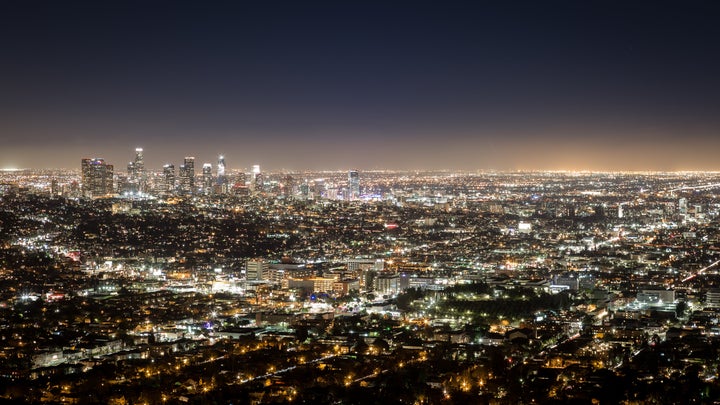
Exposure to light leads to the suppression of melatonin, a hormone critical to producing antioxidants that boost our immune system, lower cholesterol, keep our thyroid, pancreas, ovaries, testes and adrenal glands healthy, and, of course, induce sleep. While all light affects melatonin levels, blue light (as produced by most LEDs and electronics) has been found to be the most harmful to humans.
In 2007, the World Health Organization’s International Agency for Research on Cancer added overnight shift work to its list of probable carcinogens. And in 2012, the American Medical Association also recognized light pollution as a health risk.
Studies have now shown that light pollution disrupts our sleep cycle, including a report connecting outdoor light at night with insomnia.
Our bodies are being bombarded with photons. From football stadium floodlights or traffic lights blinking through your curtains at 2 a.m. to the constant blue glare from our laptop and phone screen, every aspect of our lives is now disrupted by artificial light.
Nocturnal Wildlife
But after the sun goes down, and our final scroll through Instagram is complete, we close our eyes for some much-needed sleep. Meanwhile, the nocturnal creatures are only just waking up.
Nighttime is a busy time for nature. But people may not think about it, says Gormley, “because they’re usually in bed asleep, and they don’t see the impact that our lights can have on these creatures.”
One way this can be seen, though, she says, is when people wake up in the morning to dead birds near the side of their homes. This usually happens because “they left their lights on and the birds have collided into windows,” Gormley explains.
According the Canadian nonprofit Fatal Light Awareness Program (FLAP), more than a billion birds die each year in North America due to collisions with buildings.
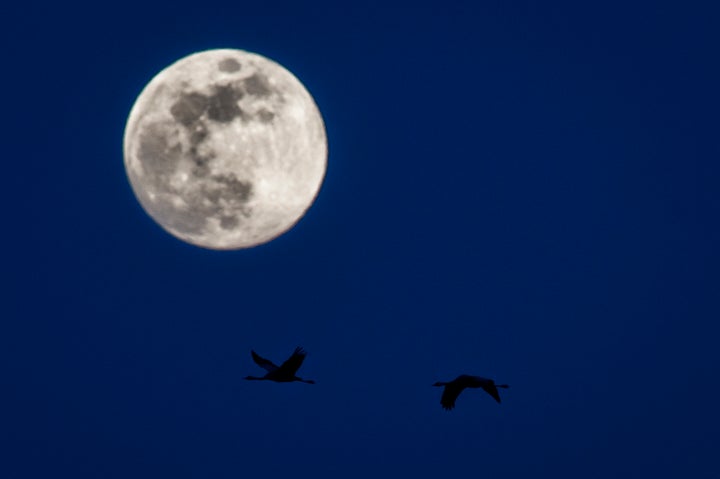
Much like the feeling when you’re driving at night and a car speeds toward you with its high beams on, this is what it can be like for nocturnal animals encountering bright city lights.
The phrase “blind as a bat” isn’t really true, explains Stephanie West, biodiversity training manager at the U.K. Natural History Museum. In fact, bats are adapted to fly in low-light conditions and are able to see better than humans can when it’s dark. “But it means that bright floodlights and things like that are very blinding to them. Hit with a bright street light shining straight in their faces, it’s going to disorientate them, it’s going to completely blur their vision.”
Beyond bats, about 30% of vertebrates around the world, such as owls, deer mice, raccoons and foxes, and more than 60% of invertebrates, like moths and fireflies, are nocturnal.
There are a number of reasons why animals prefer to venture out at night. It could be that there’s less competition for food — or a better chance of avoiding becoming someone else’s food — or that the lower temperature is better for exhausting migratory journeys.
Some insects use the night sky to get their navigational bearings. On moonless nights, for instance, the yellow underwing moth orients itself to the North Star. And dung beetles use the Milky Way to help them efficiently roll their poop piles toward a safe spot for eating.
But our drive for bigger and brighter lights is disrupting the system. We’re all used to seeing flies bump repeatedly into a street lamp or a moth sit transfixed against the glare, but, according to one estimate, 30% to 40% of insects that swarm our street lights die shortly afterward — from collision, overheating, dehydration or predation.
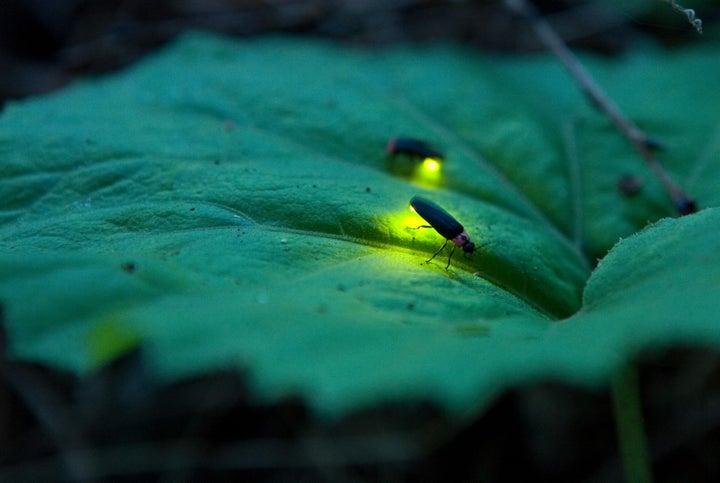
And among most North American species of firefly, a gentle burst of light is used to attract a mate. This bioluminescent courtship signal, however, is obscured by street lights, and some studies suggest this is making it more difficult for males and females to find each other. Increasingly, scientists suspect light pollution is contributing to the observed loss of firefly species.
The effect of this disruption isn’t contained to the nocturnal world. Agriculture, for example, relies on these critical ecosystem services, from natural pest control to maintaining soil quality. For those of us who like tequila, for example, bats are integral to pollinating the spiky desert agave plant from which the spirit is derived.
Taking Action
Developers and housing planners are becoming more aware of these considerations, says West. In the past five years, “this has hit the forefront of people’s minds, in terms of bat conservation,” she says. The U.K. now has guidance from the Bat Conservation Trust as well as the Institution of Lighting Professionals for best practices on lighting installations to protect wildlife.
Arizona, a longtime hub of astronomy, has had light pollution laws since 1986. Texas is the only state with laws targeting light pollution from military installations.
And in Puerto Rico, before Hurricane Maria (which led to the largest and longest blackout in U.S. history), there was a growing concern about the effect of light pollution — from harming people’s ability to see the island’s famous bioluminescence in its lagoons and bays to disorienting nesting sea turtles who may then stay away from the beaches. This concern prompted Puerto Rico’s government to introduce a new law in 2008 to control and prevent light pollution, including building code provisions for exterior lighting.
From the shape of the light itself to the types of lightbulbs, “there are loads of different things that can be done,” says West. Having lamps that direct light downward toward the pavement, for instance, is an easy switch to ensure that what needs to be lighted is lighted, rather than “producing huge globes of light” projecting into the sky, she explains.
In 2017, a community of 102 homes in Fort Collins swapped out 172 porch lamps for fixtures directing light down. Virtually everyone in the neighborhood participated. The following year, they swapped out 65 street lamps for downward-pointing ones. The local government helped the residents measure their energy savings and find new dark sky-compliant fixtures to help cut down on light pollution.
“We’ve seen some traction and interest in a few different pockets,” says Sawyer. Building on this, the city recently launched a rebate program for individuals who want to trade in inefficient outdoor fixtures for night sky-friendly ones.
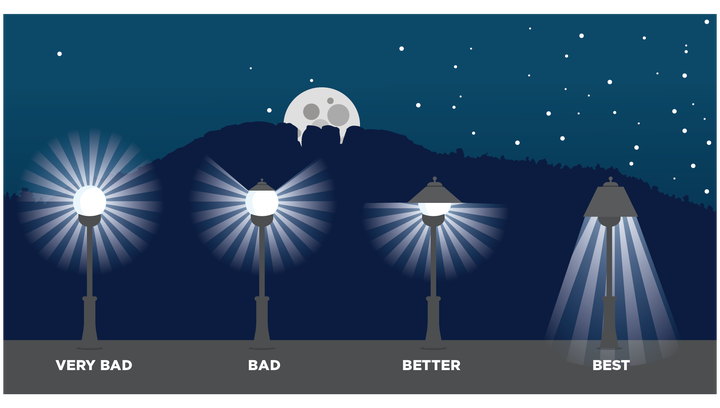
Light pollution is pretty wasteful. At least 30% of all outdoor light is just excess, ending up in the sky rather than on its target. According to one estimate, this unshielded outdoor light represents $2 billion to $3 billion in additional energy costs each year in the United States — that’s equal to 8.2 million tons of coal burned and represents 21 million tons of carbon dioxide emissions annually.
But the focus on efficiency has been almost exclusively on LED bulbs. This drive for energy-efficient lighting, says Gormley, is an emerging culprit in driving light pollution: “What’s happening is, because lights are becoming cheaper with recent technology, decision-makers are thinking, ‘Oh, wow, lighting is cheaper, and I can give more of it to my community.’”
Instead, she argues, “we need to be thinking really smart about the way that we light.”
“Because it is possible to have light that helps us find our way, that helps us feel safe, that makes it so that we can live and work in communities,” Gormley adds, “but also protects the night sky for the public good, for wildlife, for energy efficiency and also just so we can have that experience of connecting with the universe.”
Colorado is among the top 10 fastest-growing states in the country. So, for places like Fort Collins, whose population of 175,000 is expected to double over the next 20 to 30 years, development is constantly on peoples’ minds. “A big topic here is growth,” says Sawyer. “Growth is coming, we’re not stopping it, we can’t build a wall around our community and shut it down. So, we know it’s coming, so how do we do it in a way that’s least impactful?”
As one recent study put it: “A critical question for sustainable development is whether the use of outdoor light will continue to grow exponentially or whether developed countries are nearing saturation in demand.”
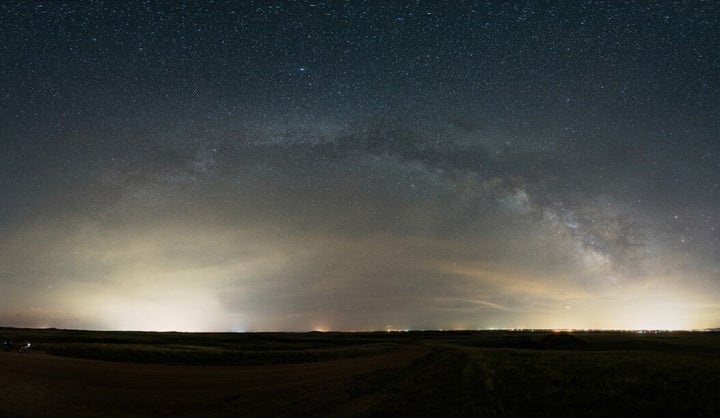
One of the biggest challenges is developers and businesses who are used to more traditional lighting and levels of light, Sawyer explains. It’s really difficult, she says, to properly grasp best practice codes by simply reading them on paper.
To help overcome this barrier and allow developers to visualize what the changes would look like in practice, Fort Collins is working on a case study to compare the lighting installed for recent projects — such as a new convenience store or a hotel — with what it would look like if these same projects used night sky-friendly lighting standards.
Ultimately, says Sawyer, the question is how can we make this change in a “very conscious, positive way?”
Thirty years ago, light pollution used to really only be a concern to astronomers — because they were typically the only ones up at night studying the sky. But now, with the popularity of night sky photography, in particular, Gormley says, interest has taken off. People are now starting to actively seek out the experience of seeing the stars.
Gormley often asks people why the night sky matters or how they feel under the night sky. And the answer is usually something along the lines of “I feel small and insignificant but in a really powerful way,” or “It reminds me how small our differences are from each other, and how connected I am to the world.”
“And I just think that in this moment in our culture, that’s such a deep need that we all have to be connected to each other and to recognize how small our differences are when during the day we feel they’re really big,” she reflects, “and then at night the sun goes down, the stars come out, this dome of sparkling stars come up over our head, and we’re just reminded how tiny we are in comparison to the universe.”
If it matters to you, it matters to us. Support HuffPost’s journalism here. For more content and to be part of the “This New World” community, follow our Facebook page.
HuffPost’s “This New World” series is funded by Partners for a New Economy and the Kendeda Fund. All content is editorially independent, with no influence or input from the foundations. If you have an idea or tip for the editorial series, send an email to thisnewworld@huffpost.com.